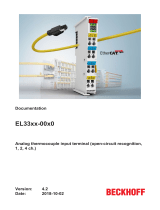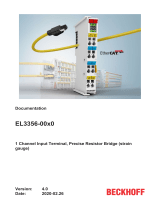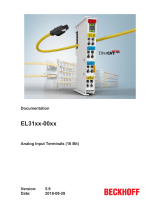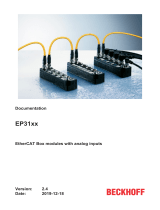Page is loading ...

Application Report
SLAA362 – June 2007
Set Up and Use TSC Timings
Wendy Fang .................................................................................... Precision Analog Applications, HPA
ABSTRACT
This application report helps users to understand, set up, and use the programming
timings in the register-based touch screen controller (TSC) devices. It displays the
timings functions and discusses the effect on the system interface traffic and on the
system power consumption.
Contents
1 Introduction .......................................................................................... 2
2 Touch Panel Driving Power ....................................................................... 2
3 Effect of ADC Clock ................................................................................ 4
4 Panel Voltage Stabilization Time ................................................................. 6
5 Other TSC Timings ................................................................................. 7
6 Conclusion ........................................................................................... 9
7 References .......................................................................................... 9
List of Figures
1 Block Diagram of a Touch Screen System Using TI's TSC2004/5/6 Device ............... 2
2 Touch Panel Power Consumption ................................................................ 3
3 Analog Interface Under ADC Clock = 2 MHz .................................................. 5
4 Analog Interface Under ADC Clock = 1 MHz .................................................. 5
5 Panel Voltage Stabilization 0 µ s, 100 µ s, and 500 µ s ......................................... 6
6 Precharge Time on TSC Analog Interface Lines ............................................... 8
7 Sense Time on TSC Analog Interface Lines .................................................... 9
List of Tables
1 TSC2004/5/6 CFR (Configuration Registers) Timing Settings................................ 3
SLAA362 – June 2007 Set Up and Use TSC Timings 1
Submit Documentation Feedback

www.ti.com
1 Introduction
Resistive
Touch
Screen
Processor
X+,X-, Y+, Y-
I2CorSPIbus
Interrupt
{
AnalogInterface
{
Digital
Interface
AnalogInterfaceandInternalCircuitsPoweredbySNSVDD DigitalIOPoweredbyIOVDD
TSC2004
TSC2005or
TSC2006
2 Touch Panel Driving Power
Introduction
Texas Instruments produces a family of high-performance, resistive touch screen controller (TSC) devices,
such as ADS7846 or TSC2005.
A TSC device goes between a resistive touch screen (panel) and a host processor. The panel functions as
the touch sensor, and the processor usually is the center of multiple tasks/functions in an application or
product.
Figure 1 is a typical 4-wire, resistive TSC system. A TSC device has two interfaces: the analog interface is
the connection to the panel, and the digital interface is the bridge to the processor.
Figure 1. Block Diagram of a Touch Screen System Using TI's TSC2004/5/6 Device
TI's TSC devices were designed with inventive features and many advantages such as:
• Acquiring precise and reliable touch data
• Cutting power consumption of the touch screen system
• Reducing the interference and overhead to the processor
This application report focuses only on the functions and characteristics of several programmable timings,
featured in the register-based TI TSC devices, such as the TSC2004, the TSC2005, and the TSC2006.
These programmable timings significantly affect the analog interface and should be set up to optimize the
entire system's performance.
On a resistive touch screen system, the touch panel's driving current, provided by the TSC device through
the analog interface, has the highest impact on the power consumption in the touch screen system. This
touch panel power consumption is decided by the touch panel's resistance and the TSC power supply
(SNSVDD) voltage. Figure 2 shows the relationship. The touch screen is driven by the touch screen
controller from the giving SNSVDD, and the panel's resistance determines the peak drive current.
2 Set Up and Use TSC Timings SLAA362 – June 2007
Submit Documentation Feedback

www.ti.com
Touch Panel Driving Power
Figure 2. Touch Panel Power Consumption
Figure 2 considers only the ideal TSC driving condition where the TSC's internal resistance is ignored
because it is small (5 Ω to 6 Ω ) comparing to the touch panel's resistance (100s to 1000s Ω ). Thus, the
actual power consumption in practice should be a little less than that shown in Figure 2 .
A user can reduce power consumption in three ways:
1. Use touch screens with higher resistance
2. Use low power supply SNSVDD to the TSC
3. Reduce the driver-ON time or the driver's ON/OFF ratio.
Touch panels with higher resistance are likely to cause more noise and longer settling time, which limits
selection options for users.
The TSC2004/5/6 has the lowest power supply requirement in today's market. The TSC2004/5/6 is
designed with its power supply SNSVDD in the range of 1.6 Vdc to 3.6 Vdc and can still function well with
the SNSVDD power supply as low as 1.4 Vdc.
To reduce the driver-ON time involves setting various touch screen timings and delays, which is the main
topic of this application report. Table 1 lists relevant parameters concerning these timings and delays. The
sections that follow detail their functions and effects.
Table 1. TSC2004/5/6 CFR (Configuration Registers) Timing Settings
Settings Location Description How to Effect Power
CL1~CL0 D12~D11 of CFR0 ADC Conversion Clock Control: Faster f
ADC
CL1~CL0 = 00b — f
ADC
= f
OSC
(CL1~CL0 = 00b) uses shorter time and
CL1~CL0 = 01b — f
ADC
= f
OSC
/2 thus less SNSVDD power
CL1~CL0 = 10b — f
ADC
= f
OSC
/4
PV2~PV0 D10~D8 of CFR0 Panel Voltage Stabilization (PVS) Time Control: Shorter PVS time PV2~PV0 = 000b)
(Time between panel driver ON and starting uses shorter driver ON time and thus
sample) less SNSVDD power
From 0 µ s (PV2~PV0 = 000b)
to 100 ms (PV2~PV0 = 111b)
SLAA362 – June 2007 Set Up and Use TSC Timings 3
Submit Documentation Feedback

www.ti.com
3 Effect of ADC Clock
Effect of ADC Clock
Table 1. TSC2004/5/6 CFR (Configuration Registers) Timing Settings (continued)
Settings Location Description How to Effect Power
PR2~PR0 D7~D5 of CFR0 TSC wait-time to allow the pin's capacitance to be Not consuming extra SNSVDD power
fully precharged
From 20 µ s (PR2~PR0 = 000b)
to 1.364 ms (PR2~PR0 = 111b)
SN2~SN0 D4~D2 of CFR0 TSC wait-time to sense if the screen is touched Not consuming extra SNSVDD power
after converting a touch coordinate.
From 32 µ s (SN2~SN0 = 000b)
to 2.656 ms (SN~SN0 = 111b)
BTD2–BTD0 D2~D0 of CFR1 Batch Delay Timing Discussed by a separate application
report on TSC Operation Schemes
(SLAA359 )
A TSC2004/5/6 device contains a nominal 4-MHz internal clock, which is used to drive the state machines
inside the device that performs the many functions. This clock is divided down to provide a clock to run the
SAR A/D converter. If the 4-MHz clock is used directly (divided by 1), the A/D converter is limited to a
10-bit resolution; using higher resolutions at this speed does not result in accurate conversions. The 12-bit
resolution requires that the conversion clock run at either 2 MHz (divided by 2) or 1 MHz (divided by 4).
The division ratio for the ADC clock is set in the configuration register 0 or CFR0, by CL1 and CL0 bits.
See CL1~CL0 in Table 1 .
The ability to change the conversion clock rate allows the user to choose the optimal value for the ADC
resolution, speed, and power dissipation. Higher clock frequency results in faster touch data converting
speed, shorter touch driver-ON time, and thus usually lower SNSVDD power consumption.
Figure 3 and Figure 4 shows an example on the ADC clock's effect on the analog interface traffic, i.e., X+,
X–, Y+, and Y- lines. In these illustrations, a TSC drives the touch panel to acquire X, Y, Z1, and Z2
coordinates, and three samples per coordinate. Figure 3 is an analog interface with the clock frequency
set to 2 MHz; Figure 4 has a 1-MHz clock frequency. In Figure 3 and Figure 4 , other than the ADC clock
frequency difference, all other settings were completely identical, that is, PVS = 0 µ s, PR = 20 µ s, and SN
= 32 µ s (these timers are discussed in the next section).
The ADC clock frequency determines the length of the TSC acquisition time and TSC driver-ON time. The
faster the ADC clock, the shorter the driver is on. For example, sampling 3 Y data with ADC clock = 2
MHz uses only about 1/2 time comparing to that with ADC clock = 1 MHz, comparing Figure 3 to Figure 4 .
4 Set Up and Use TSC Timings SLAA362 – June 2007
Submit Documentation Feedback

www.ti.com
I + ƒ
ǒ
V
SNSVDD
Ǔ
)
ǒ
V
SNSVDD
R
Ǔ
ǒ
SSPS S B
F
Ǔ
(1)
Effect of ADC Clock
Figure 3. Analog Interface Under ADC Clock = 2 MHz
Figure 4. Analog Interface Under ADC Clock = 1 MHz
Mathematically, the analog power supply SNSVDD current can be expressed by.
SLAA362 – June 2007 Set Up and Use TSC Timings 5
Submit Documentation Feedback

www.ti.com
4 Panel Voltage Stabilization Time
Panel Voltage Stabilization Time
Where, I denotes the SNSVDD current, and it includes two parts: the internal circuitry power consumption
or ƒ (VSNSVDD); and the current to drive the external resistive touch panel or as expressed in Equation 1
that V
SNSVDD
/R × SSPS × S × B / F.
In Equation 1 :
V
SNSVDD
is the SNSVDD voltage (in V);
R is the touch panel's average resistance (in Ω );
SSPS is S ample Sets Per Second, which indicates how many sets of touch data the host gets within a
second;
S is the number of data in a set of samples;
B is the TSC resolution, either 10 bit or 12 bit; and
F is ADC clock frequency, which can be 4, 2, or 1 MHz.
A concern for using the faster ADC clock is due to the analog interface's settling timing or transients; the
higher clock frequency may reduce the data's accuracy in those cases where the TSC starts its data
acquisitions before the analog interface lines reach the stable voltages. Therefore, it may be necessary to
add some delays on the analog interface in order to wait for the interface to become stable before an ADC
starts working. These delays may include the panel voltage stabilization time, the pins' precharge time,
and/or the sense time, as is discussed next.
Panel voltage stabilization (PVS) time specifies a delay time from the moment the touch screen drivers are
enabled, to the time the voltage is sampled and a conversion is started. These bits allow the user to adjust
the appropriate settling time for the touch panel based on the external capacitances at the analog
interface lines.
Figure 5. Panel Voltage Stabilization 0 µ s, 100 µ s, and 500 µ s
Figure 5 shows examples where with PVS = 0 µ s (no PVS delay), 100 µ s, and 500 µ s. In the examples,
the TSC takes the sets of 4 x 3 = 12 data, and they are 3 X, 3 Y, 3 Z1, and 3 Z2. Because TSC2004/5/6
always performs the Y coordinate first when it was set to X/Y or X/Y/Z scan mode, the sequence for
getting a set of samples in Figure 5 is:
• TSC adds driver power to Y+ (SNSVDD) and Y- (AGND); waits PVS µ s; and acquires 3 Y data;
• TSC adds driver power to X+ (SNSVDD) and X- (AGND); waits PVS µ s; and acquires 3 X data; and
• TSC adds driver power to Y+ (SNSVDD) and X- (AGND); waits PVS µ s; and acquires 3 Z1 and 3 Z2
data.
6 Set Up and Use TSC Timings SLAA362 – June 2007
Submit Documentation Feedback

www.ti.com
I
PVS
+
ǒ
V
SNSVDD
R
Ǔ
SSPS PVS 3
(2)
I + ƒ
ǒ
V
SNSVDD
Ǔ
)
ƪ
V
SNSVDD
R
SSPS
ǒ
S B
F
) 3 PVS
Ǔ
ƫ
(3)
I + ƒ
ǒ
V
SNSVDD
Ǔ
)
ƪ
V
SNSVDD
R
SSPS
ǒ
S B
F
) 2 PVS
Ǔ
ƫ
(4)
5 Other TSC Timings
Other TSC Timings
The PVS delay consumes power because a driver is ON during the PVS delay. The power can be
expressed as:
Where PVS is the PVS delay/wait time and 3 here is due to X, Y, and Z driver ON. Thus, a complete
expression of analog power consumption can be, based on Equation 1 :
for X/Y/Z 3-dimension coordinates. Similarly, for X/Y 2-dimension touch data, it becomes:
Unlike the ADC clock frequency (CL1~CL0) and panel voltage stabilization time (PV2~PV0), the other two
TSC timings in CFR0 (Table 1 ) affect the bus shape and traffic speed but do not effect power
consumption of the analog interface.
As can be seen in Figure 5 that there are some added time/delay between samplings of two coordinates,
such as the time after sampling Y and before X driver ON, which are the precharge time (PR2~PR0) and
sense time (SN2~SN0).
The precharge time (PR2~PR0) sets the amount of time allowed for precharging any pin capacitance on
the touch screen during the TSC ADC conversions as shown by Figure 6 .
SLAA362 – June 2007 Set Up and Use TSC Timings 7
Submit Documentation Feedback

www.ti.com
PrechargeTimeorPR
Other TSC Timings
Figure 6. Precharge Time on TSC Analog Interface Lines
The sense time (SN2~SN0) sets the amount of delay for the TSC device to wait between two coordinates
during TSC ADC conversions, as shown by Figure 7 .
8 Set Up and Use TSC Timings SLAA362 – June 2007
Submit Documentation Feedback

www.ti.com
6 Conclusion
7 References
Conclusion
Figure 7. Sense Time on TSC Analog Interface Lines
If a pressure remains on the touch panel, the TSC devices may automatically and continuously acquire
touch data; as many as several thousands SSPS of touch data can be driven-ON, sampled, converted,
and processed. For a real-world application, however, users usually need only 100 ~ 500 SSPS touch
data due to a human's controlling/responding limit. To save power, users often do not want the system to
acquire any unnecessary data.
A touch screen controller's SSPS can be reduced in several ways:
• Use the batch delay to add waiting time between the sets of touch data
• Insert delays, such as PR and SN (but not PVS), to slow down the coordinate samples within a set
because PR and SN do not consume power.
See Table 1 for their bit locations and for the selectable time ranges.
This application report discusses the programmable timings and functions in TI TSC2004, TSC2005, or
TSC2006 touch screen controller device. These timings includes the ADC clock frequency (CL1~CL0), the
touch panel voltage stabilization time (PV2~PV0), the TSC input pins' precharge time (PR2~PR0), and the
sense time between coordinate samples (SN2~SN0).
All timing settings affect the analog interface traffic speed and interval. In addition, the ADC clock
frequency (CL) and the touch panel voltage stabilization time (PVS) affect analog interface power
consumption.
1. Operation Schemes of Touch Screen Controllers application report (SLAA359 )
2. UNPUBLISHED TSC2004, 1.2V to 3.6V, 12-Bit, Nanopower, 4-wire Touch Screen Controller With
I2C™ Interface data sheet (SBAS408 )
3. TSC2005, 1.6V to 3.6V, 12-Bit, Nanopower, 4-wire Touch Screen Controller With SPI™ Interface data
sheet (SBAS379 )
SLAA362 – June 2007 Set Up and Use TSC Timings 9
Submit Documentation Feedback

IMPORTANT NOTICE
Texas Instruments Incorporated and its subsidiaries (TI) reserve the right to make corrections, modifications, enhancements,
improvements, and other changes to its products and services at any time and to discontinue any product or service without notice.
Customers should obtain the latest relevant information before placing orders and should verify that such information is current and
complete. All products are sold subject to TI’s terms and conditions of sale supplied at the time of order acknowledgment.
TI warrants performance of its hardware products to the specifications applicable at the time of sale in accordance with TI’s
standard warranty. Testing and other quality control techniques are used to the extent TI deems necessary to support this
warranty. Except where mandated by government requirements, testing of all parameters of each product is not necessarily
performed.
TI assumes no liability for applications assistance or customer product design. Customers are responsible for their products and
applications using TI components. To minimize the risks associated with customer products and applications, customers should
provide adequate design and operating safeguards.
TI does not warrant or represent that any license, either express or implied, is granted under any TI patent right, copyright, mask
work right, or other TI intellectual property right relating to any combination, machine, or process in which TI products or services
are used. Information published by TI regarding third-party products or services does not constitute a license from TI to use such
products or services or a warranty or endorsement thereof. Use of such information may require a license from a third party under
the patents or other intellectual property of the third party, or a license from TI under the patents or other intellectual property of TI.
Reproduction of TI information in TI data books or data sheets is permissible only if reproduction is without alteration and is
accompanied by all associated warranties, conditions, limitations, and notices. Reproduction of this information with alteration is an
unfair and deceptive business practice. TI is not responsible or liable for such altered documentation. Information of third parties
may be subject to additional restrictions.
Resale of TI products or services with statements different from or beyond the parameters stated by TI for that product or service
voids all express and any implied warranties for the associated TI product or service and is an unfair and deceptive business
practice. TI is not responsible or liable for any such statements.
TI products are not authorized for use in safety-critical applications (such as life support) where a failure of the TI product would
reasonably be expected to cause severe personal injury or death, unless officers of the parties have executed an agreement
specifically governing such use. Buyers represent that they have all necessary expertise in the safety and regulatory ramifications
of their applications, and acknowledge and agree that they are solely responsible for all legal, regulatory and safety-related
requirements concerning their products and any use of TI products in such safety-critical applications, notwithstanding any
applications-related information or support that may be provided by TI. Further, Buyers must fully indemnify TI and its
representatives against any damages arising out of the use of TI products in such safety-critical applications.
TI products are neither designed nor intended for use in military/aerospace applications or environments unless the TI products are
specifically designated by TI as military-grade or "enhanced plastic." Only products designated by TI as military-grade meet military
specifications. Buyers acknowledge and agree that any such use of TI products which TI has not designated as military-grade is
solely at the Buyer's risk, and that they are solely responsible for compliance with all legal and regulatory requirements in
connection with such use.
TI products are neither designed nor intended for use in automotive applications or environments unless the specific TI products
are designated by TI as compliant with ISO/TS 16949 requirements. Buyers acknowledge and agree that, if they use any
non-designated products in automotive applications, TI will not be responsible for any failure to meet such requirements.
Following are URLs where you can obtain information on other Texas Instruments products and application solutions:
Products Applications
Amplifiers amplifier.ti.com Audio www.ti.com/audio
Data Converters dataconverter.ti.com Automotive www.ti.com/automotive
DSP dsp.ti.com Broadband www.ti.com/broadband
Interface interface.ti.com Digital Control www.ti.com/digitalcontrol
Logic logic.ti.com Military www.ti.com/military
Power Mgmt power.ti.com Optical Networking www.ti.com/opticalnetwork
Microcontrollers microcontroller.ti.com Security www.ti.com/security
RFID www.ti-rfid.com Telephony www.ti.com/telephony
Low Power www.ti.com/lpw Video & Imaging www.ti.com/video
Wireless
Wireless www.ti.com/wireless
Mailing Address: Texas Instruments, Post Office Box 655303, Dallas, Texas 75265
Copyright © 2007, Texas Instruments Incorporated
/





